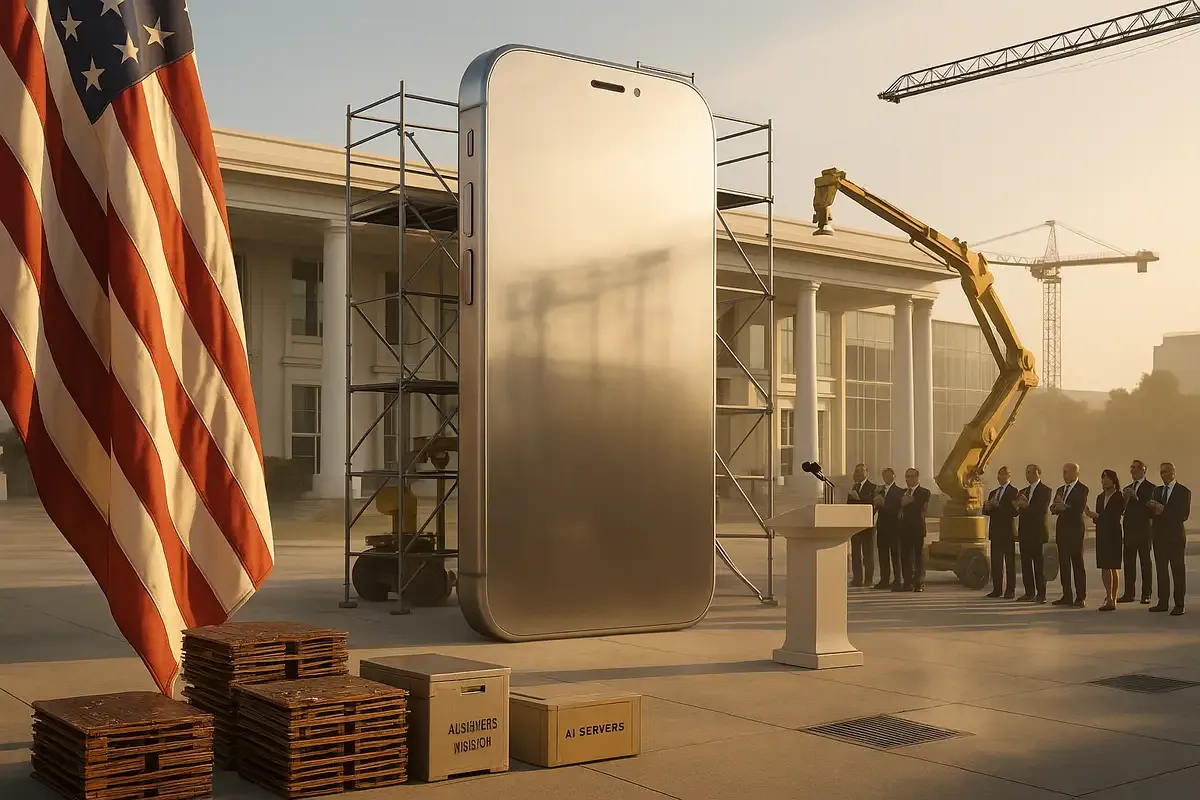💡 TL;DR - The 30 Seconds Version
📱 Apple announced $100 billion in new US manufacturing investment Wednesday, bringing its four-year total to $600 billion—but iPhone assembly stays in Asia.
💰 Moving iPhone production to America would push prices past $2,000 per phone, according to industry analysts who cite lack of US manufacturing infrastructure.
🎯 Trump imposed 50% tariffs on India hours before Apple's announcement, after threatening 25% iPhone taxes unless production moves to the US.
📊 Apple's stock jumped 6% on the news—its best day since May—while the company faces $1.1 billion in expected tariff costs this quarter.
🏭 The Kentucky glass factory Apple touted already made iPhone glass since 2007; most "new" investments repackage existing spending plans.
🎭 This marks Apple's fourth major US investment announcement since 2018, each carefully timed to avoid tariffs while keeping actual manufacturing unchanged.
Apple just committed another $100 billion to US manufacturing. The announcement came Wednesday afternoon at a White House event with Tim Cook and Donald Trump, bringing Apple's total US investment pledge to $600 billion over four years.
Trump had just doubled tariffs on India to 50% that same morning. He's threatened Apple with a 25% iPhone tax unless the company moves production to America. The message was clear: play ball or pay up.
Apple's new American Manufacturing Program sounds impressive. Corning will dedicate an entire Kentucky factory to making Apple's glass, expanding its workforce there by 50%. Applied Materials and Texas Instruments signed on as partners. Cook talked about bringing "critical components" back home. The stock market loved it—Apple shares jumped 6%, their best day since May.
The $2,000 iPhone Problem
But here's what Apple isn't doing: moving iPhone assembly to the United States. Not now, not ever, if Cook can help it. The math doesn't work. Industry analysts say building iPhones in America would push prices past $2,000. The US hasn't made smartphones at scale for over a decade. We don't have the engineers. We don't have the workers. We certainly don't have the infrastructure that China and India spent decades building.
Cook learned this dance during Trump's first term. Promise big numbers. Hold splashy events. Keep the actual manufacturing exactly where it makes economic sense. In 2018, Cook toured a Texas facility with Trump, presenting it as a new Apple plant. The facility had been making Mac computers since 2013. Apple later moved that production to Thailand.
Look at the numbers. Back in 2018, Cook announced $350 billion. Three years later, $430 billion. This February, $500 billion. Now another hundred billion on top. Every time, the press releases include spending Apple had already budgeted—data centers, stores, regular operations. It's creative accounting at its finest.
Gene Munster from Deepwater Asset Management put it bluntly: "The end game here is mostly about getting good with the administration on tariffs."
Cook's Impossible Choice
Cook's strategy makes sense. Apple faces an impossible choice. Trump wants iPhones made in America—he's said so repeatedly. In May, he complained about Apple building "all over India." In Qatar, he told reporters he had "a little problem with Tim Cook" over the India expansion. The president even skipped Cook's name during a Saudi Arabia tech delegation, pointedly praising Nvidia's CEO instead while noting "Tim Cook isn't here."
Meanwhile, Apple needs factories in Asia. They buy parts from suppliers across the globe. Most assembly happens in China, but they've been moving work to Vietnam, Thailand, and India for years now. Cook admitted last week that most iPhones Americans buy come from India these days.
This expansion into India particularly irritates Trump. Wednesday morning, Trump hit India with those 50% tariffs over Russian oil. Hours later, Cook's at the White House announcing his investment. The connection's obvious. Back in April, Apple rushed 1.5 million phones from India into the US. They saw this coming.
The financial stakes keep climbing. Apple took an $800 million tariff hit last quarter. They expect $1.1 billion in tariff costs this quarter if nothing changes. Trump's planning new levies on all products containing semiconductor chips. Every Apple product contains chips.
The Art of the Non-Deal
So Cook does what he's always done: announce investments that sound transformative but change little. The new $100 billion includes existing supplier relationships. It counts routine spending on data centers. It adds up salaries for employees Apple would hire anyway.
The Kentucky glass factory? Corning already made glass for the first iPhone there. The "new" Houston facility for AI servers? Part of plans announced months ago. The promise to hire 20,000 Americans? Apple employs 90,000 in the US already—normal growth would hit that target.
Wednesday's announcement did include one genuinely new element: the American Manufacturing Program brand. It packages existing initiatives under a patriotic banner. Smart politics, minimal disruption.
Apple has reason to play this carefully. Unlike software companies that can operate anywhere, Apple needs Asian manufacturing expertise. Moving iPhone production would take years and billions in capital investment. It would require training hundreds of thousands of workers. It would mean building entire supplier ecosystems from scratch.
Wayne Lam from TechInsights doesn't mince words about the challenge. The US lacks manufacturing engineers. It lacks skilled assembly workers. Even with unlimited money, building the necessary infrastructure would take a decade.
Theater That Works—For Now
Cook knows this. Trump's advisers probably know it too. But the theater continues. Trump gets his announcement. Cook gets his tariff exemptions. Apple keeps making phones where it makes sense.
The irony is that Apple already contributes significantly to the US economy. The company supports 450,000 American jobs through suppliers and partners. It spends billions on US-designed chips. Its app economy generates hundreds of billions in revenue. But none of that involves assembling iPhones in Detroit.
Bloomberg Intelligence analysts Anurag Rana and Andrew Girard see through the performance: Apple will "focus on higher-end products, artificial intelligence labs and semiconductor engineering in the US, rather than mass-produced lower-end phones and accessories." Translation: the prestigious stuff stays here, the actual manufacturing stays in Asia.
Not everyone's impressed. Apple's mixed record on fulfilling investment promises undermines the fanfare. That Texas plant Cook toured with Trump? Still waiting for expansion. The new campus Apple promised in 2018? Never materialized. Some commitments simply fade away once headlines pass.
Raymond James analyst Munster expects this pattern to continue. "I don't see Apple coming back another six months from now with another $50 billion. This should be enough."
The Limits of Reshoring
Enough for what? To avoid immediate tariffs, certainly. To maintain access to Asian manufacturing, probably. To actually bring iPhone production to America? Don't count on it.
The real question is whether Trump accepts this arrangement. His administration wants reshoring, not press releases. They want factories, not funding promises. Wednesday's announcement buys time, but it doesn't solve Apple's fundamental problem: their business model depends on global supply chains that Trump wants dismantled.
For now, Cook's strategy works. The stock market rewards the announcement. Trump claims victory. Apple continues operating largely as before. But tariff threats remain. India tensions escalate. The semiconductor investigation looms.
Cook's betting he can navigate these challenges like he did in Trump's first term—with strategic announcements, relationship building, and careful politics. Wednesday's $100 billion pledge represents another move in that game.
But games end. At some point, Apple might face a real choice: pay tariffs, move manufacturing, or find a third option nobody's thought of yet. Until then, expect more announcements, more White House events, and more creative accounting of what constitutes "American investment."
The Kentucky glass factory will certainly appreciate the attention.
Why this matters:
• Apple's investment pledges show how major corporations navigate Trump's tariff threats through strategic announcements rather than fundamental business changes—a pattern other companies will likely follow
• The impossibility of moving iPhone production to the US reveals the limits of reshoring complex manufacturing, even with political pressure and unlimited capital
❓ Frequently Asked Questions
Q: Why can't America manufacture iPhones?
A: The US lacks the specialized workforce and infrastructure. China employs 300,000+ workers just for iPhone assembly, with engineers trained specifically for electronics manufacturing. Building this capacity would take a decade and push iPhone prices past $2,000, according to TechInsights analysts.
Q: What will Apple's $100 billion actually buy?
A: Mostly component manufacturing—glass at Corning's Kentucky factory, chips from Texas Instruments, and materials from Applied Materials. The money also covers existing operations like data centers, R&D facilities, and the planned Houston AI server factory. No new iPhone or Mac assembly plants.
Q: Where are iPhones actually made now?
A: Most iPhones sold in America now come from India, Cook confirmed last week. China still handles most global production, with factories in Vietnam and Thailand picking up some work too. Not a single iPhone gets assembled in the United States.
Q: How much would Trump's threatened tariffs cost consumers?
A: Expect to pay $200-300 more per iPhone if Trump's 25% tariff hits. That's based on Apple's quarterly tariff bill of $1.1 billion divided by their sales. Apple might eat some of the cost, but analysts say you'll end up paying most of it.
Q: Has Apple delivered on previous US investment promises?
A: Mixed results. The 2018 promise of a new campus never materialized. The Texas facility Trump toured as "new" in 2019 had operated since 2013 and later moved production to Thailand. Apple counts routine spending toward its targets, making real impact hard to measure.
Q: Why did Trump hit India with 50% tariffs?
A: Trump cited India's continued purchases of Russian oil as the official reason. But timing suggests it's also about Apple moving iPhone production there. Trump specifically complained in May about Apple "building all over India" instead of America.
Q: What American jobs does Apple actually support?
A: Apple has 90,000 employees in the US working retail, corporate, and R&D jobs. They also support 450,000 more through suppliers who make parts, run data centers, and build apps. But assembly line jobs—the blue-collar manufacturing Trump wants—remain almost entirely overseas.








